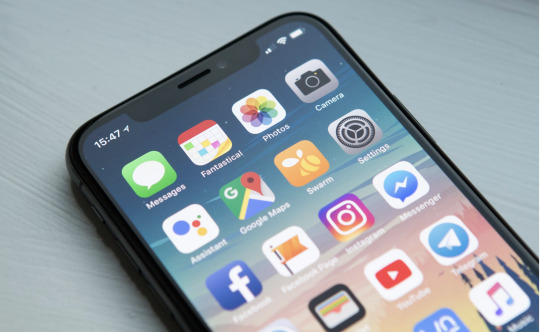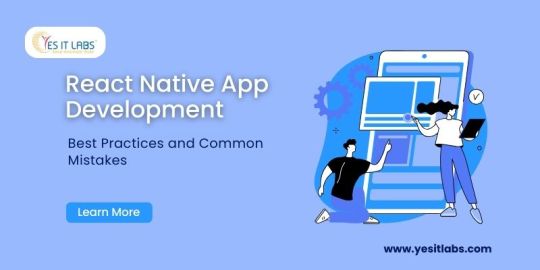#App development best practices
Explore tagged Tumblr posts
Text
#Mobile app development mistakes#App development best practices#Mobile app design errors#Common app development pitfalls#Mobile app user experience#App performance issues#Mobile app functionality flaws#App development tips#Mobile app testing#Mobile app optimization
1 note
·
View note
Text
Navigating the App Store Submission Process: Tips and Best Practices

The journey from a brilliant app idea to seeing it live on the App Store can be thrilling, but the submission process itself? Often, it feels like navigating a labyrinth. Apple's stringent guidelines and review process, while ensuring quality and security, can be daunting. Fear not! This blog will equip you with the essential tips and best practices to streamline your app submission and increase your chances of a smooth approval.
1. Understand Apple's App Store Guidelines (ASG): Your Holy Grail
Before writing a single line of code, dive deep into the Apple App Store Guidelines. They are the foundation of the submission process. Familiarize yourself with:
Design Guidelines: Ensure your app aligns with Apple's Human Interface Guidelines (HIG) for a consistent user experience.
Functionality Guidelines: Understand the prohibited functionalities and ensure your app's features comply.
Business Guidelines: Be aware of Apple's policies on in-app purchases, subscriptions, and advertising.
Privacy Guidelines: Prioritize user privacy and data security. Clearly outline your data collection and usage practices.
2. Thorough Testing: Bug-Free is the Way to Be
Apple prioritizes a seamless user experience. Rigorous testing is crucial.
Device Diversity: Test your app on a variety of iOS devices and screen sizes.
Beta Testing: Utilize TestFlight to gather feedback from real users before submitting.
Edge Cases: Identify and address potential issues that might arise under unusual circumstances.
Performance Testing: Ensure your app is responsive and doesn't drain battery excessively.
3. Optimize Metadata: Your App's First Impression
Metadata is how users discover your app. Make it count!
App Name: Keep it concise, relevant, and memorable.
Keywords: Research and use relevant keywords to improve search visibility.
App Description: Clearly explain your app's features and benefits. Highlight its unique value proposition.
Screenshots and App Previews: Showcase your app's best features with high-quality visuals.
Category Selection: Choose the most appropriate category to reach your target audience.
4. Prepare for Review: Anticipate Questions
Apple's review team might have questions about your app's functionality or content. Be prepared to provide:
Demo Account: If your app requires login, provide a demo account for review.
Test Data: Include relevant test data to demonstrate your app's functionality.
Explanatory Notes: If your app has unique features or requires specific configurations, provide clear instructions.
Contact Information: Ensure your contact information is accurate and up-to-date.
5. App Store Connect: Your Central Hub
App Store Connect is your portal for managing your app submissions.
Accurate Information: Double-check all information before submitting, including pricing, availability, and localization.
Version Control: Utilize version control to track changes and manage updates.
Review Status: Monitor your app's review status and respond promptly to any feedback from Apple.
Resolution Center: Use the resolution center to communicate with Apple's review team and address any issues.
6. Localization: Reach a Global Audience
If your app targets a global audience, localization is essential.
Translate Content: Translate your app's text, metadata, and visuals into relevant languages.
Cultural Adaptation: Consider cultural nuances and adapt your app's design and functionality accordingly.
Right-to-Left Support: Ensure your app supports right-to-left languages if necessary.
7. Stay Updated: Apple's Policies Evolve
Apple's App Store Guidelines and policies are subject to change. Stay informed about the latest updates to ensure your app remains compliant.
Apple Developer Website: Regularly check the Apple Developer website for announcements and updates.
WWDC Sessions: Attend or watch WWDC sessions to learn about new features and guidelines.
Developer Forums: Engage with the developer community and stay informed about industry best practices.
Also read : How machine learning can help revamp mobile app ?
8. Don't Give Up: Rejections are Part of the Process
App rejections are common. Don't be discouraged.
Understand the Reasons: Carefully review the rejection reasons provided by Apple.
Address the Issues: Make the necessary changes to comply with the guidelines.
Resubmit with Clear Explanations: Clearly explain the changes you've made in your resubmission notes.
By following these tips and best practices, you can navigate the App Store submission process with confidence and increase your chances of a successful launch. Remember, patience, attention to detail, and a commitment to quality are key. Good luck!
#mobile app development company in london#mobile app designers in london#app development company in london#mobile app developer in london#app developer in london#Navigating the App Store Submission Process: Tips and Best Practices
0 notes
Text
Shopify Webhooks Best Practices
Webhooks are a powerful tool in Shopify that allow developers to automate workflows, integrate third-party services, and keep external applications in sync with store data. By using Shopify webhooks, businesses can receive real-time updates on orders, customers, inventory, and more. However, improper implementation can lead to security risks, data inconsistencies, and performance issues. In this…
#API Call Optimization#E-commerce Automation#E-commerce Scalability#Real-Time Data Sync#Secure Webhook Implementation#Shopify API Integration#Shopify App Development#Shopify Development#Shopify Store Management#Shopify Webhooks#Shopify Workflow Automation#Webhook Performance Optimization#Webhook Security#Webhooks Best Practices
0 notes
Text
#effective project planning#mobile app development company#project planning best practices#project planning steps#project planning techniques
0 notes
Text
Mobile Optimization for Shopify Apps: Best Practices
Learn the art of designing Shopify navigation menus that simplify user journeys, improve accessibility, and elevate your e-commerce performance.

0 notes
Text
#react native#be careful#architecture#buidlings#apps#native app development#growth#best practices#programming#technology#future trends#artificial intelligence#machine learning#follow#coding#branding#ai#trends 2024#singto prachaya
0 notes
Text
Mastering Mobile App Security: Best Practices for Securing React Native Apps
Discover essential techniques for securing React Native apps. This guide covers best practices for React Native security, ensuring you protect user data and enhance your mobile app development process.
#Securing React Native Apps#Best Practices for React Native Security#React Native Security Techniques#Mobile App Security#React Native Development#Protecting User Data in React Native
0 notes
Text
Best Practices to develop features of E-commerce
The text emphasizes the critical importance of stability in e-commerce applications in 2024, as well as the challenges that arise when adding new features to these platforms.

It outlines the essential features of e-commerce apps, including fast loading, secure payments, seamless checkout, personalized recommendations, and data privacy, but underscores that these must all be supported by a stable, bug-free system to ensure user satisfaction.
Key Features of E-commerce Apps in 2024
1)Fast loading: Quick page loading is crucial for user retention.
2) Detailed product info: Comprehensive information helps users make informed decisions.
3) Effective search and filtering: Users should easily find products.
4) Secure payment: Trustworthy payment systems ensure user confidence.
5) Seamless checkout: A smooth, straightforward checkout process reduces cart abandonment.
6) Data privacy: Users demand that their personal and payment information be protected.
7) Personalized recommendations: AI-driven suggestions enhance user experience.
8) Easy returns: Simplifying returns and refunds encourages purchases.
Reasons New Features Cause Issues
1)Code complexity: New features increase code, leading to potential bugs.
2) Resource overload: Extra processing power may slow down or crash the system.
3) Poor integration: Misalignment with existing features can cause errors.
4) Database overload: Increases in database activity can crash the app.
5) Dependency conflicts: Updating libraries or frameworks may create incompatibilities.
6) Concurrency issues: High user traffic can overwhelm the system.
Solutions to Mitigate Issues
1)Thorough testing: Comprehensive testing (unit, integration, user acceptance) before deploying new features.
2) Scalable architecture: Ensure the system can handle increased loads.
3) Frequent code reviews: Regularly assess the code to catch bugs early.
4) CI/CD pipelines: Automate testing and deployment to maintain safe integration.
5) Performance monitoring: Use tools to track and address performance issues post-launch.
6) Database optimization: Optimize queries and storage to handle increased demands.
7) Gradual rollouts: Deploy features to a small group first to monitor for issues.
8) Clear documentation: Maintain detailed documentation of changes to track issues.
9) Fallback mechanisms: Implement systems to ensure failures don’t disrupt the entire app.
10) Configuration management: Ensure new features are properly configured and tested.
Conclusion:
A stable, feature-rich, and user-friendly e-commerce app is key to thriving in today’s competitive market. To avoid disruption and ensure stability, businesses need expert teams with deep experience in e-commerce development. This includes continuously optimizing and scaling architecture, testing new features, and maintaining application performance.
#e-commerce functionality#e-commerce website features#e-commerce app development#development best practices
0 notes
Text
#iOS Mobile App Development Technologies#Technologies for iOS App Development#iOS App Development Tools and Frameworks#Best Technologies for iOS Development#iOS Development Languages and Tools#iOS App Development Best Practices#iOS Mobile Development Frameworks 2024#Technologies Used in iOS App Development#Top iOS Development Tools and Languages#iOS Mobile App Development Guide
0 notes
Text
Augmented Reality (AR) in Ionic Apps: Transforming User Experiences
Augmented Reality (AR) is revolutionizing user engagement with mobile applications. By overlaying digital information in the real world, AR provides immersive experiences that engage users like never before. The Ionic Framework, known for its robust and flexible app development capabilities, is perfectly suited for incorporating AR, transforming user experiences, and setting new standards in app design.
What is Augmented Reality (AR)?
Augmented Reality (AR) combines the physical world with digital content, enhancing real-world environments with computer-generated perceptual information. Unlike Virtual Reality (VR), which creates a completely virtual environment, AR overlays digital elements onto the real world, providing a blended view that enhances the user's perception of reality.
The Ionic Framework
Ionic is an open-source framework that facilitates the creation of high-quality mobile and desktop apps using web technologies like HTML, CSS, and JavaScript. Its key features include a comprehensive library of pre-designed components, powerful CLI tools, and seamless integration with various front-end frameworks. Ionic's versatility and ease of use make it a popular choice for developers aiming to create innovative applications.
Benefits of Integrating AR in Ionic Apps
Integrating AR into Ionic apps offers several advantages:
Enhanced User Engagement: AR adds an interactive layer to applications, making them more engaging and enjoyable.
Improved User Experience: AR provides intuitive and immersive experiences, leading to higher user satisfaction.
Competitive Advantage: Offering AR features can differentiate your app in the competitive app market, attracting more users.
Key AR Features in Ionic Apps
Real-time Object Recognition: AR can instantly identify and interact with physical objects.
Spatial Mapping: AR creates a detailed map of the surrounding environment, enabling more accurate and immersive experiences.
Interactive User Interfaces: AR enhances user interfaces, making them more dynamic and interactive.
Tools and Technologies for AR in Ionic
Several tools and technologies are available for integrating AR into Ionic apps:
ARCore by Google: Brings advanced AR features to Android platforms.
ARKit by Apple: Offers AR features for iOS devices.
Vuforia and Other AR SDKs: Third-party SDKs that provide additional AR functionalities.
Setting Up an Ionic Project for AR Development
Installing Ionic: Begin by installing the Ionic CLI.
Setting up ARCore/ARKit: Integrate ARCore for Android or ARKit for iOS into your project.
Project Configuration: Configure your project to include necessary dependencies and settings for AR development.
Building Basic AR Functionality in Ionic
Creating an AR Scene: Set up the initial AR environment.
Adding AR Objects: Incorporate digital objects into the AR scene.
Implementing User Interactions: Enable interactions between users and AR elements.
Advanced AR Features in Ionic Apps
Marker-based AR: Uses specific images or objects as triggers for AR content.
Markerless AR: Does not rely on specific markers, allowing for more flexible and dynamic experiences.
Location-based AR: Leverages GPS data to place AR content according to the user's location.
Challenges in Developing AR with Ionic
Optimizing Performance: Prioritize seamless and responsive AR interactions.
Device Compatibility: Addressing variations in AR capabilities across different devices.
User Experience Design: Creating intuitive and user-friendly AR interfaces.
Best Practices for AR Development in Ionic
Testing and Debugging: Thoroughly test AR features to ensure reliability and performance.
Cross-Platform Compatibility: Ensure your AR app works seamlessly on both Android and iOS.
User-Centric Design: Focus on creating AR experiences that meet user needs and expectations.
.
Future Trends of AR in IonFAQsic Apps
The potential for AR in app development is More:
Emerging Technologies: Stay updated with the latest AR tools and frameworks.
Innovative Features: Anticipate new AR capabilities that can enhance app experiences.
AR's Future: Delve into how AR will continually transform mobile app development.
Conclusion
Augmented Reality in Ionic apps offers unparalleled opportunities to create engaging and immersive user experiences. By leveraging the power of AR, developers can build innovative applications that stand out in the competitive app market. With continuous advancements in AR technology, the future of AR in Ionic apps is bright, promising even more exciting developments.
1. How do AR and VR differ?AR integrates digital content with the real world, while VR immerses users in a completely virtual environment.
2. In what ways can AR improve user experiences in apps?AR delivers interactive and immersive experiences, significantly boosting user interaction and satisfaction in apps.
3. What are the key tools for AR development in Ionic? Key tools include ARCore for Android, ARKit for iOS, and third-party SDKs like Vuforia.
4. What are the common challenges in AR development? Challenges include performance optimization, device compatibility, and user experience design.5. How can I get started with AR development in Ionic? Start by installing Ionic, setting up ARCore/ARKit, and configuring your project for AR development.
#How to implement Augmented Reality in Ionic apps#Benefits of AR in Ionic app development#Transforming user experiences with AR in Ionic#Best practices for using AR in Ionic framework#Step-by-step guide to adding AR to Ionic apps#Enhancing mobile app engagement with AR in Ionic#Future of Augmented Reality in Ionic applications#Creating immersive experiences with AR in Ionic#AR features to include in your Ionic app#Leveraging Augmented Reality for better user experience in Ionic apps#Developing cutting-edge Ionic apps with AR technology#Improving app interaction with Augmented Reality in Ionic#Key advantages of AR in Ionic app frameworks#Augmented Reality trends in Ionic app development#Why use AR in your next Ionic mobile app project
0 notes
Text

Essential Best Practices for Successful Mobile App Development
Discover key strategies for mobile app development success. Learn essential best practices to enhance your apps' performance, user experience, and security.
#mobile app development#best practices#app success#strategy#performance optimization#user experience#app security#development tips#modern apps#techniques
0 notes
Text
Best Practices for Flutter App Development in 2024 (clariontech.com)
#flutter#app#development#web development#app development#best#practice#flutter app#flutter app development#developer#flutter developers#flutter 2024#app 2024
0 notes
Text
Key Trends and Best Practices for iOS App Development
After phones became little colored screens in our pockets, the iOS application development process took off. The first generation of iPhone, released in 2007, opened the door for a new wave of technology, where people could spend their time on the smartphone screen and its various apps. Consumers of all ages constantly seek new ways to connect with technology and the Internet. That’s why iOS app…

View On WordPress
0 notes
Text
#Angular Modules Best Practices#Angular NgModule framework#Structuring Angular Apps#Organizing Angular Modules#Angular Application Structure#top angular development company
0 notes
Text

React Native Development: Best Practices and Common Mistakes
Take your React Native app development to new heights with tried-and-tested methods while sidestepping common pitfalls. Unlock professional guidance to craft resilient mobile applications.
#react native app development company#Best Practices for React Native App Development#IT consulting company in USA#it consulting services for business
0 notes